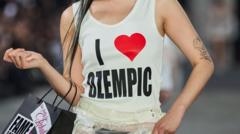The body positivity movement, which saw significant progress in the 2010s, appears to be dwindling, as the fashion industry increasingly favors skinny models. The influence of weight-loss drugs like Ozempic has further accelerated this trend, with industry insiders expressing concerns about the implications for diversity in fashion.
Fashion Industry Reverts to Skinny Models Amidst Ozempic Popularity

Fashion Industry Reverts to Skinny Models Amidst Ozempic Popularity
As the fashion world shifts away from body positivity, the rise of weight-loss medication Ozempic signals a concerning trend towards promoting thinner models.
In recent years, the fashion industry, notably during events such as Paris Fashion Week, has displayed an evident regression towards celebrating thinness. The once-prominent body positivity movement, which found energetic support in the 2010s, is now facing challenges as designers and brands gravitate back to conventional beauty standards. This shift is drawing attention not only from insiders but also from advocates who fear that inclusivity is losing ground.
Originating in the 1960s and reviving in the social media era of the 2010s, the body positivity movement marked a crucial change towards welcoming diverse body types on runways. Key moments were seen with figures like Ashley Graham breaking through barriers, inspiring a new wave of acceptance. Brands like Rihanna's Savage x Fenty pioneered inclusive runway shows, showcasing models of all sizes and reshaping consumer expectations.
However, as the current decade unfolds, the landscape appears to be shifting. Reports show only 0.8% of models in recent fashion weeks were plus-sized, a stark contrast to previous years. The popularity of weight-loss drugs such as Ozempic has introduced new dynamics, making thinner body shapes increasingly aspirational among models and consumers alike. High-profile endorsements from celebrities and public figures have propelled the drug into the limelight, influencing public perception of beauty.
Industry insiders, including models and designers, express concern over this backlash against body positivity. Moya, a working model, emphasizes the pressure to conform to a thinner ideal, stating that while it might mean more job opportunities, it's ultimately a toxic pursuit of unattainable standards. This sentiment resonates with Chioma Nnadi, British Vogue's editorial director, who acknowledges that the renewed focus on thinness risks regressing the industry’s progress on body diversity.
In a provocative cultural statement, the Berlin brand Namilia controversially showcased a T-shirt emblazoned with the phrase "I love Ozempic," highlighting the uneasy merging of fashion, beauty standards, and drug culture. Nan Li, the brand's creative director, voiced her concerns about the normalization of weight loss drugs in mainstream fashion narratives.
As fashion weeks continue, critiques have emerged regarding industry elitism, which often excludes diverse body representations. Some casting directors openly admit a preference for models that align with traditional beauty standards, reflecting a systemic practice that prioritizes commercial viability over inclusivity.
Despite the apparent shift back to narrow definitions of beauty, voices like that of designer Charles Jeffrey insist on the moral obligation of the industry to foster diversity. His shows reflect the richness of body diversity inherent in the communities he draws from, standing as a testament to the hope that inclusion can persist even amidst prevailing trends of exclusion.
Ultimately, in a consumer-driven sector, the future trajectory of body positivity in fashion may hinge on collective purchasing choices. Advocates for change remind us that consumer demand can pivot the industry's direction, suggesting that the pendulum of body representation may yet swing back toward a broader acceptance of all body types. As industry stakeholders grapple with identity politics and evolving tastes, they remain hopeful that the rich history of inclusivity can reclaim its place at the forefront of fashion narrative.
Originating in the 1960s and reviving in the social media era of the 2010s, the body positivity movement marked a crucial change towards welcoming diverse body types on runways. Key moments were seen with figures like Ashley Graham breaking through barriers, inspiring a new wave of acceptance. Brands like Rihanna's Savage x Fenty pioneered inclusive runway shows, showcasing models of all sizes and reshaping consumer expectations.
However, as the current decade unfolds, the landscape appears to be shifting. Reports show only 0.8% of models in recent fashion weeks were plus-sized, a stark contrast to previous years. The popularity of weight-loss drugs such as Ozempic has introduced new dynamics, making thinner body shapes increasingly aspirational among models and consumers alike. High-profile endorsements from celebrities and public figures have propelled the drug into the limelight, influencing public perception of beauty.
Industry insiders, including models and designers, express concern over this backlash against body positivity. Moya, a working model, emphasizes the pressure to conform to a thinner ideal, stating that while it might mean more job opportunities, it's ultimately a toxic pursuit of unattainable standards. This sentiment resonates with Chioma Nnadi, British Vogue's editorial director, who acknowledges that the renewed focus on thinness risks regressing the industry’s progress on body diversity.
In a provocative cultural statement, the Berlin brand Namilia controversially showcased a T-shirt emblazoned with the phrase "I love Ozempic," highlighting the uneasy merging of fashion, beauty standards, and drug culture. Nan Li, the brand's creative director, voiced her concerns about the normalization of weight loss drugs in mainstream fashion narratives.
As fashion weeks continue, critiques have emerged regarding industry elitism, which often excludes diverse body representations. Some casting directors openly admit a preference for models that align with traditional beauty standards, reflecting a systemic practice that prioritizes commercial viability over inclusivity.
Despite the apparent shift back to narrow definitions of beauty, voices like that of designer Charles Jeffrey insist on the moral obligation of the industry to foster diversity. His shows reflect the richness of body diversity inherent in the communities he draws from, standing as a testament to the hope that inclusion can persist even amidst prevailing trends of exclusion.
Ultimately, in a consumer-driven sector, the future trajectory of body positivity in fashion may hinge on collective purchasing choices. Advocates for change remind us that consumer demand can pivot the industry's direction, suggesting that the pendulum of body representation may yet swing back toward a broader acceptance of all body types. As industry stakeholders grapple with identity politics and evolving tastes, they remain hopeful that the rich history of inclusivity can reclaim its place at the forefront of fashion narrative.





















